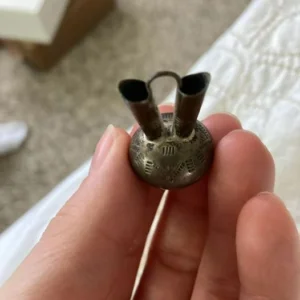In the heart of Native American cultural ceremonies, certain artifacts hold timeless significance, connecting the past and present.
Among these, the Native American wedding vase stands as a revered symbol of unity and commitment, traditionally used in wedding ceremonies to honor the sacred bond between partners.
A Cultural Heirloom with Deep Roots
Imagine the atmosphere at a traditional gathering where elders share stories and artifacts that echo the community’s heritage and values.
The wedding vase, with its distinctive two-spouted design, plays a unique role in these ceremonies, symbolizing the commitment of a couple as they journey together through life.

For those who have witnessed this ceremonial act, the memory of the couple drinking together from the wedding vase likely stands as a powerful moment of unity and reverence.
Crafting the Wedding Vase: A Spiritual Process
Each wedding vase is crafted with care and intentionality by a skilled tribal artisan, beginning with the gathering of clay from lands sacred to the community. This isn’t just any clay—it’s a material respected and treated with care, often representing the earth itself, which holds deep cultural meaning.
After the clay is meticulously cleaned and prepared, the artisan handcrafts the two-spouted vase, representing the individual lives of the bride and groom that will soon merge into one.
The unique shape of the wedding vase is not only functional but deeply symbolic. The two spouts signify the separate paths of the individuals, while the shared base represents their unified journey ahead.
Each step of the crafting process is imbued with cultural meaning, making the vase not just an object, but a vessel of tradition and spiritual intention.
Symbols of Nature and Spirit in Design
Once shaped, the wedding vase is adorned with designs that carry profound significance. Artisans often incorporate symbols of nature, such as the earth, water, or sky, which are revered in Native American cultures for their life-sustaining properties.
Animals, too, are frequently featured, each symbolizing specific virtues or embodying tribal totems. These intricate decorations not only add beauty but also infuse the vase with blessings and prayers for the couple’s shared future.
Examples of Symbolism in Wedding Vase Design
- Water Elements: Representing life, growth, and renewal.
- Animal Totems: Wolves for loyalty, eagles for vision, and bears for strength.
- Earth and Sky: Honoring the balance and connection between all life.
These designs are more than just aesthetic choices—they are spiritual symbols that bless the couple’s union and link them to their community’s heritage.
The Wedding Ceremony: Unity in Ritual
During the wedding ceremony, the wedding vase becomes the central element of a unique ritual. Filled with a sacred liquid—often water symbolizing purity, or an herbal mixture significant to the tribe for its healing properties—the vase is offered to the couple.
They each drink from their respective spouts simultaneously, a graceful yet challenging act that represents their unity and the balance they will bring to their married life.

This shared act of drinking from the wedding vase without spilling is considered a good omen, symbolizing the couple’s ability to face life’s challenges together with cooperation and harmony.
It is more than just a ritual; it is a teaching moment, emphasizing the values of balance, mutual support, and respect that are essential in marriage.
Embracing Tradition in Contemporary Life
While many Indigenous communities have adapted to modern influences, the use of the wedding vase remains a cherished tradition.
For couples, it serves as a link to their cultural roots, a reminder of the values passed down through generations. Even as wedding practices evolve, this ceremony continues to bridge the old and the new, connecting couples with their heritage.
Preserving the Vase as a Symbol of Legacy
After the wedding ceremony, the wedding vase takes on new life as a treasured keepsake. Many couples display it proudly in their home, serving as a daily reminder of their vows and the love and support of their community.
In some families, the wedding vase is passed down from one generation to the next, carrying with it stories, blessings, and the legacy of ancestors.
The Vase as a Family Heirloom
In many traditions, the wedding vase is not only a keepsake but an heirloom. Passed down through generations, it becomes a living artifact of family heritage, embodying the shared experiences, wisdom, and blessings of those who came before.
The Role of Cultural Artifacts in Ceremony
The Native American wedding vase is a profound example of how cultural artifacts hold meaning beyond their physical form.
In these ceremonial moments, objects like the wedding vase reinforce social bonds and cultural identity, bridging individuals within a community and across generations. This tradition, rich in symbolism and spiritual significance, offers insight into the enduring value of heritage in Indigenous communities.
In a world where customs are increasingly blended and redefined, the wedding vase remains a powerful reminder of the importance of preserving cultural traditions, fostering unity, and honoring the wisdom of the past.








